Having heard the name "Klopogon" for the first time, most often it seems an unsightly simple plant, which is unlikely to attract the attention of modern gardeners. However, in fact, this herbal plant will become a real decoration of any plot.
Klopogon has gentle and elegant colors, as well as a compact and unusual appearance of the bush. This plant will certainly want to grow any gardener. After all, the main feature of Calopogon is his unpretentiousness and excellent endurance. And thanks to the enormous variety of varieties of this culture, you can easily recreate any landscape design on your site.
In this article, we will look at the features and description of the Klopogon, as well as we describe the main and most common types and varieties of this plant. In addition, we note all the important nuances of agrotechnika growing.
Features and description of Klopogon
Klopogon, Camicifuge, Voronets, snake root, silver candles - so much titles have this unusual and very bright plant. In the usual use among the gardeners, a simple name is Klopogon, which originates from the Latin word Cimicifuga. It is literally translated indicates the "running bedbugs". That was exactly the purpose of this plant in distant times. In German, this plant is called "silver candles", which most accurately allows you to describe the appearance of the flower - long blossoms with delicate silver flower.
Clopogon is a perennial, herbal plant, which refers to today to the family of the Voronet and the Family Family. The natural habitat of this culture is the territory of the Far East, China, Mongolia, Japan and North America. In total, these areas occur about 15 different types of clopogon. This plant is simply a real treasure for landscape designers, as it fits perfectly into any garden composition. Collopogon will undoubtedly attract attention to its appearance - a compact bush with openwork foliage, long lush and tender rollers with small flowers.
Description of Klopogona:
- Clingon is a rather large and powerful perennial, blooming, grassy, \u200b\u200bplant, which is distinguished by excellent unpretentiousness. This is one of its main advantages that attract the attention of gardeners.
- The plant itself in height can reach from 60 cm to 2 m, which allows it to be used for various garden compositions. For example, mixboraders, alpine slides.
- The flower bush is formed by one or two stems.
- The root Klopogon system is very powerful, well developed and consists of a large number of roots. It is thanks to them that the plant canopogon can survive in the most severe climatic conditions.
- The leaves are roasting, as they begin to grow at the earth itself. Pretty large and numerous.
- They can be considered the decorative value of clopogon. The shape of the leaves slightly openwork, peristo-separated. They resemble a little parsley twig.
- The color of foliage is dark green.
- The main decoration and the dignity of Klopogon is his flowers. They bloom on the tops of long floweros, which can reach height to 2 m.
- Communication itself can be from 20 to 60 cm, it all depends on a particular variety.
- The Klopogon flower consists of small, silver-white or other shades of flowers, which are located on the tops and are collected in inflorescences of 3-12 pcs. On one stem.
- Inflorescences has most often a carlike or cylindrical shape.
- The bloom of the clockon begins in the middle of the summer, but some varieties can dissolve flowers in the fall. It lasts about 1-1.5 months.
- Fruits appear on the plant not always.
- Seeds are very small, oblong shape.
- He is a very unpretentious plant that perfectly transfers cold and heat.
- Klopogon can be attributed to long-livers. This plant in one place can live up to 25 years.
Variety of species and varieties of clopogo
Today in nature there are about 10 of the most common and popular species of clopogon, which have their bright features and qualities.
American Calopogon
- The birthplace of this type of clopogan is considered the eastern territories of North America.
- It is a perennial herbaceous plant.
- In height can reach from 90 cm to 150 cm, depending on the specific variety.
- A bush consists of a large number of dark green openwork leaves.
- Flowers with small flowers of a grayish beige shade.
- Flowers are collected in private inflorescences.
- Blossom starts in the middle of summer and lasts about a month.
- The fruit is nut.
Klopogon Daursky
- The natural districts of the habitat of Klopogon Daursky is the Far East, the territory of China.
- A perennial herbaceous plant with a powerful root system.
- Klopogon Daursky can grow up to 100 cm in height.
- Stems straight and naked, only slightly pubes in the top.
- The leaves are quite large, are three-separated, consist of three parts, along the edge of the toothed.
- Leaves of dark green color.
- This type of cyamicifrai beige little flowers collected into oblongs-shaped inflorescences.
- Blossom begins in July, sometimes in August.
Klopogon branchy
- In nature, this kind of clopogan grows in North America, the Far East and China.
- A rather high plant that can achieve a two-meter height.
- This species refers to Lodniming, as his flowers are blown in autumn, in about October.
- The leaves can have different shades: from dark green to purple and reddish brown.
- Cystic inflorescences, oblong, consist of small white colors.
Popular varieties of clopogone branches:
- Grade "Atropurpur". This variety is quite large and sizes. Stems can reach up to 2 m in height. Great decorativeness gives the coloring of foliage, which changes. Summer foliage has saturated reddish-brown color, and the leaves are greasy. Flowers white inflorescences.
- Grand "Frau Herms". This is a dwarf variety of a branched branch, which can grow only 40 cm maximum. White inflorescences.
- Grade "Pink Spike". A fairly new variety of this culture, which is distinguished by an unusual coloring leaves. All foliage has a beetted shade, which is also characteristic of the Blopogan infraces.
Kushoid clopogon
- In nature, this kind of clockon grows in the territory of the East of North America.
- Kushoid clopogon is a perennial herbaceous plant.
- A bush is formed by reprehensive, branched stems, which can be in height to reach 2 m.
- The bush itself is very wide and branched, in diameter can reach 60 cm.
- The leaves are large, consist of two or three parts, along the edge of the gear. The stalk is fastened with cuffs.
- The root system is very powerful, consists of a large number of roots.
- Inflorescences are long, sometimes reach 80 cm long.
- Flowers small, white shade with a pleasant honey aroma.
- Blossom begins in July.
Klopogon Simales
- This species of clockon grows on the extensive territory of Russia, Japan and Mongolia.
- The root system is well developed, greatly branched.
- In height, the plant can reach 1 m.
- The leaves are roasting, there may be tubes or seats. In the form of oblong, peristoids.
- White flowers are collected in busy inflorescences.
- Starts bloom at the end of August or in early September. Sometimes it does not have time to dissolve flowers.
Popular varieties of clockone simple:
- Grade "Brunette". This variety is very popular among gardeners. Differs on stems of purple color. Leaves have a brownish-purple color. Compact and dense inflorescences are made up of small white colors with a small purple tint.
- Sort "White Pearl". Leaves of this variety of light green color, twice dissected. Floweros are a bit, they end up with lush creeps-shaped snow-white inflorescences.
Klopogon smelly
- The natural habitat is considered the territory of Mongolia, Siberia.
- The name of this species of Klopogon speaks for itself. It can be used as an insecticide against bugs, which scares the smell of clockon.
- This perennial, herbaceous plant, which in height can reach from 1 m to 2 m.
- Stems straight, thick covered with hairs.
- The leaves are quite large, twice the troops, along the edges of the toothed.
- Little flowers are collected in blurred inflorescences.
- Flowers Klopogon smelly in July.
Klopogon Japanese
- Based on the name, it is clear that the territory of habitat of this species is Japan.
- A rather high plant that can grow by 1.5-2 m.
- Mid-sized leaves, dark green.
- Flowers small, cream-beige shade, sometimes silver-white.
- Collected flowers in private inflorescences.
Ways to breeding Klopogona
Cultivation of Klopogona forces even inexperienced gardener. This plant is distinguished by unpretentious and good endurance, can grow in a cold moderate climate. Klopogon can be multiplied by several ways: seeds, stalling, gaze. Consider every kind of more, after which you can choose the most suitable and acceptable.
Seed reproduction
- This method can not be applied. In the middle lane, where quite often cold weather, seeds can not always ripe.
- It is necessary to collect seeds after full maturation, which occurs in different ways, it all depends on the specific variety.
- The seeds of the clopogon are not distinguished by fierce, i.e. They are not recommended to store for a long time. Thus, you can reduce the percentage of germination in the future.
- There are two opinions about the time of sowing of the Seeds of Klopogon. One comes down to the fact that you need to hear immediately after collecting.
- According to the second point of view, it is recommended to subjected to two types of stratification, i.e. Hardening. It lasts this period of about 6 months.
- The first stratification is warm. Seeds needed for 2-3 months to keep at a temperature not lower than 20 degrees of heat.
- Next, the next 3 months of the seeds are placed in a dense package and subjected to stratification in the refrigerator at a temperature of 4 degrees.
- After that, the seeds can be heated immediately into the open ground or in the containers. The best time for sowing autumn, but you can wait for spring.
- It is not necessary to cover containers with seeds, but it is important to maintain a sufficient level of humidity.
- Seedlings appear in about six months, after which they can be transplanted to a permanent place.
- The clockon creams, grown from seeds, only in 2 years.
Reproduction of the division of the bush
- This method is simpler and it can be used for all types and varieties of clockon.
- For this plant, it is recommended after landing in 5-6 years to carry out the division of processes, which will be useful for more active growth of the parent plant. At the same time, it is possible to carry out a Calopogon transplant.
- The optimal time to divide Klopogon bushes is an early spring or August-September.
- It is necessary to choose a healthy and strong plant and dig it.
- The root Klopogon system is very unreserved, so it is necessary to separate the processes with a very sharp ax or a secateur.
- From the parent plant, it is necessary to separate subsidiaries with sprouts.
- After that, the parent plant needs to be returned to the previous place, and the young processes are best planted in a light shadow for better suggestions.
Pencornia reproduction
- It is necessary to breed with cuttings in early spring when young sprouts appear on the plant. If for some reason you did not have time, then it is better to abandon this way, since all shoots can already be delayed.
- As a cutlets, you can use a subsidiary kidney with sprouts, which is broken, not alarming the root system.
- Also use young shoots that appear early in spring. At the same time, the green cutlets need to tear off necessarily with the heel - with a piece of maternal stem.
- After that, process the prepared cuttings with a solution of growth amplifier, for example, rhoin. For this, the entire seating material placed in a container with this solution.
- It is possible to plant cuttings into an open soil that is suitable for the growth of clockon. It is usually suitable for fertile, nutritious, well-moistened soil.
- From above, the cuttings can be covered with film or plastic bottles.
- The plant obtained by drawing can be blooming this year.
Preparation before landing of the clock
Klopogon is just a leader among unpretentious plants that can easily adapt to any grade conditions. Partly precisely this is the value and the amazing quality of this plant. However, to obtain an elegant and spectacular flower, it is necessary to carefully prepare. It is necessarily important to choose high-quality and healthy seedlings and choose the most suitable place on its site.
Stage 1. Selection of clopogone seedlings
The first and, perhaps, the most important step should be the choice of seedlings. If you do not have on the site of this unusual plant and you can not prepare the planting material yourself, then buy clopogogon in specialized stores, and better in nurseries. It is here that you will preliminarily consult about the peculiarities of the cultivation of clopogon in your area, the benefits of each of the varieties. Before buying, be sure to check the seedling for damage or signs of diseases.
Stage 2. Selection of Places for Landing
Klopogon is not a very picky plant relative to the place of landing. This plant will delight magnificent, juicy foliage and delicate flowers anywhere in your site. It can be placed in the shadow or half of small trees or plants. It is also nice to feel this culture in an open space with a large amount of sunlight. However, it is not worth landing the clockon on the fully open sun, since this plant loves moisture, and in such a situation there will be a risk of drying the soil. Another condition of the optimal growth of clockone is a protected place from the winds. The plant produces long blossoms that can break from the wind.
Also, when choosing a landing site, focus on the garden arrangement you have. Clopogon looks great in single landings, may be a major emphasis in any garden composition.
Stage 3. Soil preparation before landing
Klopogon prefers to grow on fertile, nutritious, moderately moistened soils. It is important that the soil in the place you choose is loose and missed moisture well. Previously before landing, it is necessary to switch well, while remember that the soil processing must be deep.
Immediately before planting the soil, it can be fertilized by adding humus into it or complex mineral fertilizer. When preparing a landing plot, it should be borne in mind that the plant here will grow for 15-20 years, as Klopogon does not like transplants. Therefore, it is necessary to prepare the soil very well, because this will depend on the intensity of the growth of this culture.
Landing technology Klopogona
- The optimal time for the landing of the clock is spring or autumn. However, many gardeners recommend to stop the selection on the spring landing. So the plant will have time to fix the onset of frosts.
- At the selected area you need to prepare landing pits.
- Their size will be directly dependent on the overall size of a seedling together with an earthen room. Approximately the depth of the pit should be 30-40 cm.
- If you sit down several plants of Klopogon nearby, then it is necessary to make a sufficient indent between them. The root system of this culture is very powerful and branched, so they need a lot of space. The optimal distance between the two bush clock is not less than 60 cm.
- At the bottom of the dug, you can put a drainage layer. Klopogon although he loves soil moisture, but, like many plants, does not carry a long stagnation of water from the roots. As a drainage, use small stones, gravel or clay.
- Also before landing in each pit, you can add organic and mineral fertilizers in the dosage according to the instructions.
- Next, gently put a seedling into the landing pit and sprinkle its soil, tamping his hands.
- After landing, each plant should be abundantly pouring.
- It is recommended to close the surface of the soil around the mulch plant to prevent excessive evaporation of moisture. A dry peat can be used as a mulch. The main thing is not to fall asleep the mell of the soil near the stem itself, it is necessary to leave a free small plot.
Agrotechnical cultivation of clockon in the open soil
Caring for clockon is quite simple and consists in competent and moderate watering, making fertilizers and pruning.
Watering Klopogona
Klopogon is a plant that prefers moderately wet soil. Therefore, it is rarely watering, but it is plentiful to moisten the soil on sufficient depth. It is necessary to increase the amount of irrigation in the dry time when each plant should be watered once every 2-3 days.
Loosening and mulching
This culture prefers to grow in the light and loose soils, so periodically you can slightly loosen the soil around the Black cohosh. Weeds are usually near the plant does not grow, as its broad foliage does not give them a place. After irrigation and as necessary need to add mulch, which will prevent the evaporation of moisture from the soil. As the mulch you can use dry peat or sawdust, it is also suitable and foliage.
fertilizing Black cohosh
Nutritious and fertile soil - is the key to rapid growth and abundant flowering Black cohosh. First fertilizing amended during the planting of the plant. conventional, organic and mineral fertilizers suitable for Black cohosh. In the future, these plants require annual fertilizer after reaching 4-5 years. Need to feed in early spring, so that the plant made up for the necessary supply of nutrients.
Trimming
In the fall of black cohosh in need of complete pruning. In preparation for the winter, the entire plant must be completely cut off. In this case, it does not necessarily cover, black cohosh can tolerate extreme cold and frost. But if you live in the northern regions, place the cut stems can be covered fallen leaves or spruce branches. During the active flowering Black cohosh is necessary to periodically remove the faded flowers, thereby enhancing the growth and flowering of new ones.
Black cohosh transplant
This plant is very poorly tolerate transplantation, especially more mature flower. Therefore, when choosing the landing site must be considered is that in the future not to injure the black cohosh. If urgently needed to transplant the young plant Black cohosh, it is recommended to bury the roots no deeper than 10 cm It is easier to get accustomed flower.
Fighting diseases and pests
Black cohosh resistant to disease and of no interest to various pests. The only thing that can destroy the plant - the wrong care of him. In particular it concerns the watering regime. Therefore, to get healthy and strong plants, do not overdo it with the soil moisture.
Using Black cohosh in landscape design
- Black cohosh looks great in single landings. It is better to acquire the tall plants.
- This culture also effectively looks in mixed beds in combination with the blooming and other ornamental plants.
- In landscape design, black cohosh can be used for decoration of the Alpine hills. In this case, you need to choose low-growing varieties.
- As an option, this culture is perfect for framing garden paths and borders.
- An excellent place to disembark Klopogan will be a plot near water bodies or along the buildings.
Photo of clopogon in landscape design
You can more clearly see all the features of this plant, all the subtleties of its use in landscape design can be on the photos represented.
Clockon landing along with other plants
Klopogon in a single landing
Klopogon is a unique, bright and spectacular plant, which will certainly decorate any plot. Efforts that you spend on landing and growing this culture, with more thank you. After all, your "silver candles" every year will only become more beautiful.

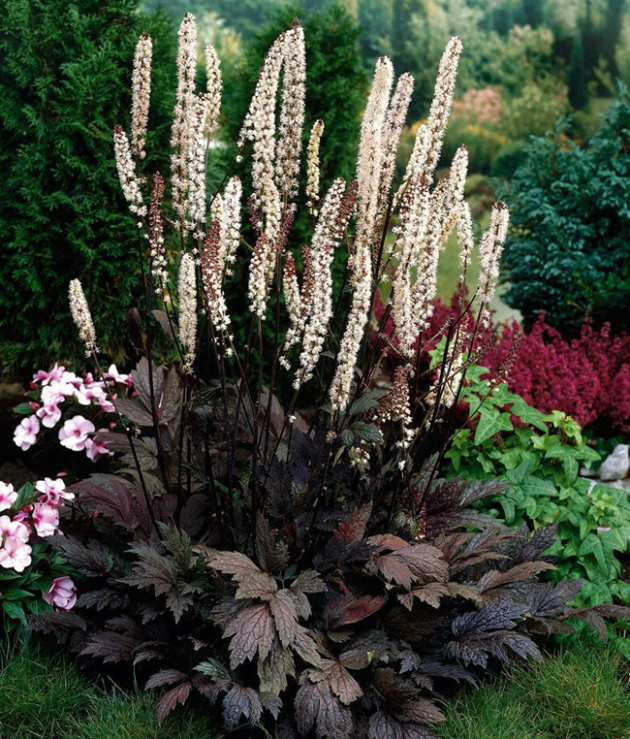
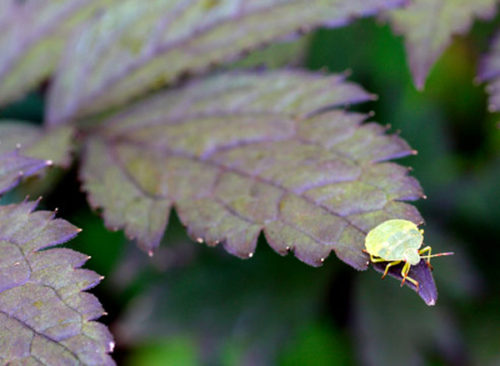
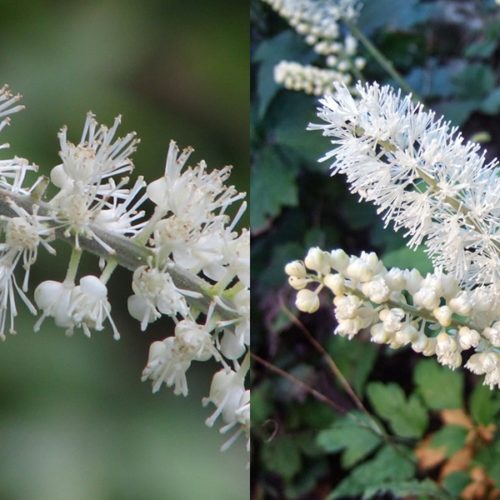
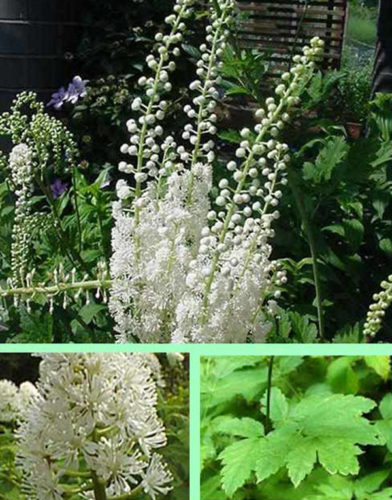
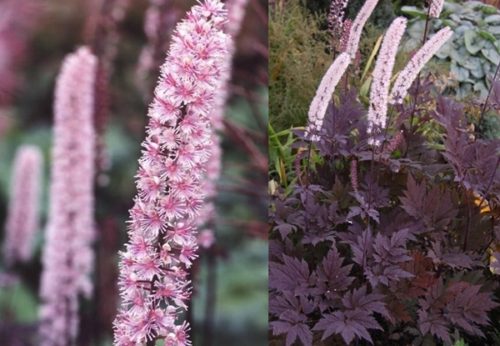
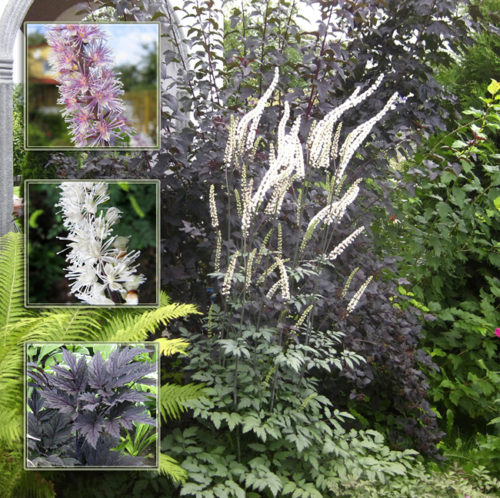
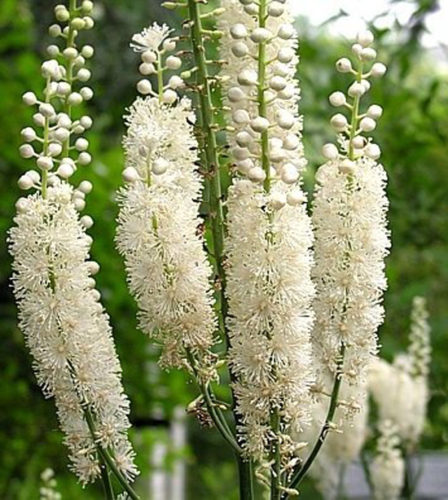
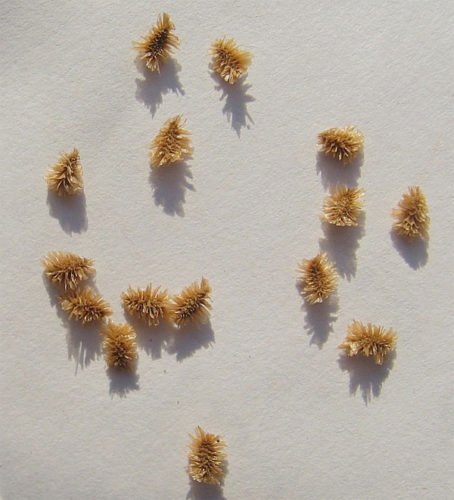
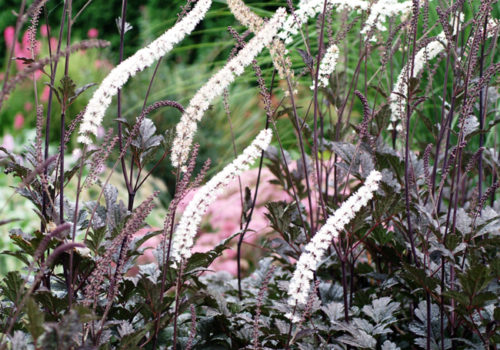
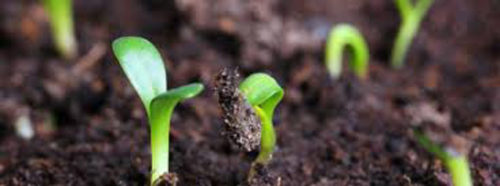

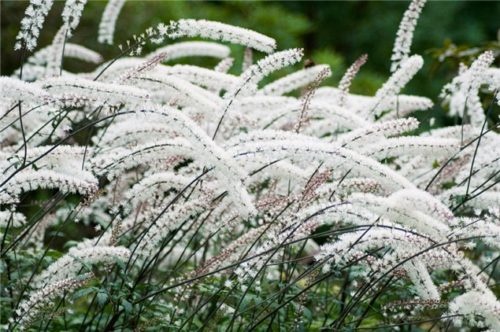
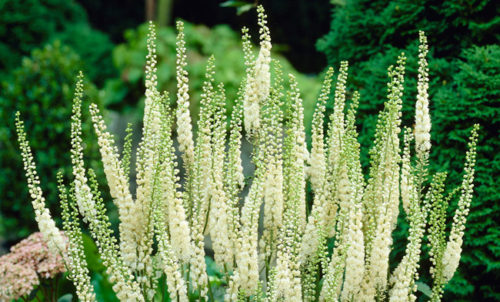
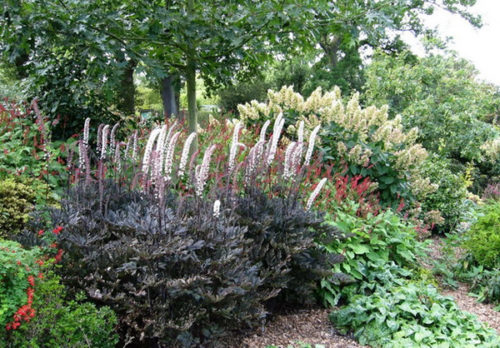
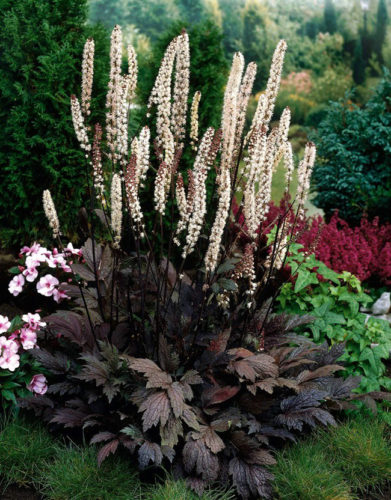












 Start a discussion ...
Start a discussion ...